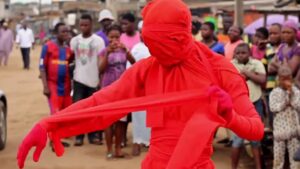
To those who aspire to performance in Africa, I would like to tell them that it’s not new. Performance has been our ancient practice for a longer time. Just do it because it’s in our DNA. For those who are not Africans, they need to accept that it’s the purest artistic form. It has no divine methods, rules and regulations. Everything depends on you and you decide how you want the audience to see you. If you choose to use your body as a material, believe that it’s meaningful and very important.
Thadde Tewa in conversation with Jelili Atiku
Red Day (detail), 2017 (see note 1)
Jelili Atiku: Performance Artist and Activist

Jelili Atiku. Photo: Enoh Lienemann
Multimedia Nigerian performance artist Jelili Atiku has become an inspirational figure to his indigenous people in Ejigbo, Nigeria and to his fans all over the world. Through his intriguing performances both in Nigeria and around the world he tries to sensitize his audience about politics, climate change and social justice. Through a skype call interview the pioneering artist, and sociopolitical and human rights activist explains to me why he uses his body as a medium in his performances, and he shares more about his devotion to his Yoruba culture and traditional beliefs as a way to self-decolonize and heal from postcolonial trauma.
The 52-year-old performer has gone through several traumatic experiences in the hands of the Nigerian police for his radical art performances he continues to fight for the rights of his indigenous people. Out of curiosity, I ask him if he will ever reach a breaking point because of all the trouble he has had as a performance artist. To Atiku there is no retiring. He passionately explains that according to the Yoruba you only retire when you die or when you cease to exist in the physical realm. It’s more than an honor to present to you my skype interview with a world renowned performance artist of our time. Enjoy the interview!
Thadde Tewa in conversation with Jelili Atiku – 6/05/2021 – 6:00 pm–7:00 pm, Nairobi, Kenya
TT: Your January 14th 2016 performance titled ‘Aragamago Will Rid this Land of Terrorism’ at Ejigbo, Nigeria that led to your arrest and remand together with five other people was so powerful and timely, I think it’s a good example of how performance as an artistic form can be a powerful tool to advocate for socio-political change, human rights and justice. Would you discuss more about the whole experience which I believe must have been so traumatizing, also what prompted the performance?
JA: Let me start by first mentioning my artistic principle, as a performance artist I try to increase the sensibility of my audience or rather I try to influence their consciousness. I try to push the boundaries to make them start to feel certain things, When I lived in Ejigbo, Nigeria that was around 2014, a horrific incident happened whereby three women were sodomized, they were sexually harassed in the market, in a public space, the incident was kept a secret, the authorities were not aware until 2015 when it was revealed through a video that went viral that the women were arrested because they stole 50 naira (0.13$) worth of pepper. They were arrested by a ‘special’ security team appointed by the King of Ejigbo, Oba Morufu Adisa A. Ojoola, stripped them naked and poured a certain type of concoction, wine and dry pepper mixture, into their private parts. This inhumane act was so disturbing, I tried to ask my people to question the king who is also my uncle about the incident but he wouldn’t listen to any of us.
So as an artist I chose to act by designing this performance titled ‘Àràgàmàgò Will Rid This Land off Terrorism’, to make a statement or rather make the audience understand the violent nature of the king. This being a very delicate matter, I chose to push the boundaries, so I used the sensitive part of the religion, the indigenous aspect of sacredness. I included five characters in my performance, with mystic figures, the image of the Òrìṣhà – Sacred deity which is so sacred to us the Yoruba people, the figures I collected were sacred, the people who joined me in the performance were also sacred. For example, chief priest the Abore of Ejigbo and another chief priest from Ọmágbò – An Òrìṣhà and another two people who were also sacred. In Yoruba when you see a sacred body like the Abore in a performance, it means the performance itself is sacred and normally it pushes the king to feel intimidated and act.
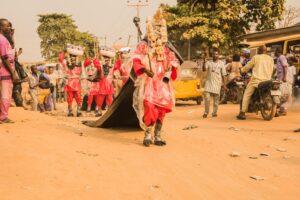
Àràgàmàgò Will Rid This Land off Terrorism, performance with Monsuru Saula, Hassan Nosiru, Jamiu Sanni and Ashimiu Muyideen, Ejigbo, Lagos, Nigeria on Thursday January 14 2016. Photo: Emmanuel Sanni.
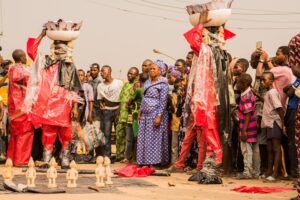
Àràgàmàgò Will Rid This Land off Terrorism, performance with Monsuru Saula, Hassan Nosiru, Jamiu Sanni and Ashimiu Muyideen, Ejigbo, Lagos, Nigeria on Thursday January 14 2016. Photo: Emmanuel Sanni.

Àràgàmàgò Will Rid This Land off Terrorism, performance with Monsuru Saula, Hassan Nosiru, Jamiu Sanni and Ashimiu Muyideen, Ejigbo, Lagos, Nigeria on Thursday January 14 2016. Photo: Emmanuel Sanni.
After the performance the King made a complaint to the police and I was arrested and remanded on January 18 2016, almost a week after the performance but the first person was arrested after three days, who was not even part of the performance, he was sent to prison the next day without even trial. After that the second person was arrested, followed by me and the two others. Luckily, the people who were part of the performance with me were not found because we alerted them in advance to disappear for their own safety. Without any investigation, which is against the law, we were taken to Kirikiri Maximum Security Prison, which is arguably one of the worst prisons in the whole world. The saddest part was the other individuals were not even part of the performance, they were in the audience, and some were just bystanders. Immediately we reached prison, as newcomers, we were welcomed by being stripped naked, searched in a very inappropriate manner. We went through one of the most animalistic treatments, for instance, sleeping naked on one side of your body in a line for 5 days in a cell of over eighty prisoners. This experience is like the slavery experiences our ancestors went through from our colonial history. This was one of the most dehumanizing experiences I have gone through as an artist. I’m still traumatized and each time I respond to this question it brings back the trauma, and the memories.
The events that followed the arrest and remand, were so traumatizing, my home was ransacked and my family terrorized. During my arrest, the youth from my community would protest outside the prison which attracted international communities in Nigeria who pushed for a public hearing and trial because they feared something bad would happen to us. So we embarked on a process to clear our names from seven charges. One of the charges was that The word ‘Aragamo’ part of the performance title was said to be a secret cult which is the name of the sacred bird that was given to the wife of Orunmila, which symbolizes the sacred power of feminine energy. One of the Nigerian artist organizations was also involved in pushing for our justice. The whole aim was to make the court and police understand that the performance was an artwork and not a criminal act which was to necessary to push the king to act or respond to the people about the domestic terrorism in his community.
Until now that experience, while in detention in both Ejigbo police station and Kirikiri Maximum Security Prison, is still one of the most traumatizing and inhumane treatments I’ve ever experienced as an artist but I’ve always managed to overcome and bounce back through support, encouragement and the strength I get from the people. The community stood firm and supported me all the way. And of course my ancestors, my Orisha and my Ori – the head, as a Yoruba person, I have to go through the Yoruba rituals, cleansing, seek protection over my sacred body and life.
As mentioned earlier about my core principle as an artist, through my performance ‘Aragamago Will Rid this Land of Terrorism’ I was hoping to show the king as a domestic terrorist which I believe I managed to push him to reveal his true nature. Also he revealed to the people that he is a liar and does not believe in his own indigenous people.
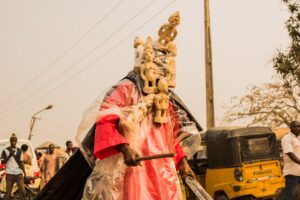
Àràgàmàgò Will Rid This Land off Terrorism, performance with Monsuru Saula, Hassan Nosiru, Jamiu Sanni and Ashimiu Muyideen, Ejigbo, Lagos, Nigeria on Thursday January 14 2016. Photo: Emmanuel Sanni.
TT: Thanks for sharing the publication links. To further my knowledge on your practice I did more research and watched some of your past performances on YouTube which are so powerful. If you don’t mind, kindly explain the meaning behind the following three performances?
E DON TEY WEY WE DEY
JA: This title is from the pidgin language, I created this performance in reaction to the people’s idea of Africa, what we are as Africans. In this performance I was trying to project that we Africans are indigenous people and ancient, our civilization has gone far before the western civilization. And we are enlightening people to establish civilization in every aspect of life. Through medicine, science, and in everything.
That’s why I painted my body brown the color of the earth or the crevice. The white lines are the experiences that we have gone through as Africans in life, the sacrifices we’ve made that make us an ancient, sound generation with a deep indigenous knowledge. And also the protection from our forefathers who watch over us. Walking in the street with people in a procession means that we are communal people, energetic, strong, we move as a community and we are always surviving. We are not as westerners who live in segments. This performance talks about the accommodative nature of us Africans. Every culture in the world has become part of us, we are so open, the westerners are not open, they don’t allow any culture to come into theirs. Therefore, we’ve become a hybrid.
Aláàgbá, performance with Cristiane Marques de Oliveira, Praça da Liberdade / Centro Cultural Banco do Brasil (CCB), Belo Horizonte, Brazil on Saturday October 11 2017.
JA: Alágbá – Is the collective circle of the Egúngún cult. Do note that I used the word with emphasis of a in the title of my performance, Aláàgbá. This is a work that talks about the collective resistance of our ancestors, Egúngún – The sacred manifestation of ancestors in Yoruba. It sheds more light on colonialism, how we are divided into units, and pushed into countries. For example, there are parts of us the Yoruba that were pushed into the Benin Republic. This division made us weaker and it became harder for us to come together as a kingdom which we are. This performance referenced Berlin conference and I see it as a form of cleansing, the abomination they have created. That’s what Aláàgbá does to heal the community through Egúngún. The first performance was done in Berlin in 2014 and the second one was done in Brazil.
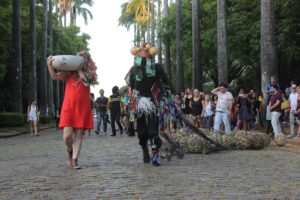
Aláàgbá, performance with Cristiane Marques de Oliveira, Praça da Liberdade / Centro Cultural Banco do Brasil (CCB), Belo Horizonte, Brazil on Saturday October 11 2017. Photo: Julia Lanari.
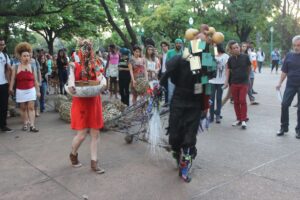
Aláàgbá, performance with Cristiane Marques de Oliveira, Praça da Liberdade / Centro Cultural Banco do Brasil (CCB), Belo Horizonte, Brazil on Saturday October 11 2017. Photo: Julia Lanari.
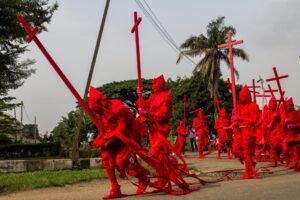
Red Day (In The Red Series #17), performance with Alo Oluwatobi Peter, Joe C. Samuel, Vincent Obinka Ikenna, Anthony Ajaero, Akinrinola Abiodun, Taiwo Aiyedogbon,Opoku Mensa, Okafor May, Titilope Salami, Remi Durosinmi-Etti Adeoye, Ogunlesi Paul Oyetunde, Jamiu Sanni, Omokeko Olufela and Silas Mensah in Lagos Biennial, Railway Compound, Ebute Metta, Lagos, Nigeria on Thursday October 19, 2017. Photo by Ayo Akinwande.
RED DAY (In the Red Day Series #17)
JA: Red Day (In The Red Series #17) is an ongoing project I started in 2009, I’ve done a lot of series on it, and it’s still ongoing. In this project I’m trying to address the human tendency to violence. How we turn our energy into destructive energy. Red is a strong energy in us, which if it’s tilted to one side it becomes destructive, if it tilts to the other side it becomes very positive and strong. So basically through in the red I try to start a dialogue about human violence attitude.

Red Day (In The Red Series #17), performance with Alo Oluwatobi Peter, Joe C. Samuel, Vincent Obinka Ikenna, Anthony Ajaero, Akinrinola Abiodun, Taiwo Aiyedogbon,Opoku Mensa, Okafor May, Titilope Salami, Remi Durosinmi-Etti Adeoye, Ogunlesi Paul Oyetunde, Jamiu Sanni, Omokeko Olufela and Silas Mensah in Lagos Biennial, Railway Compound, Ebute Metta, Lagos, Nigeria on Thursday October 19, 2017.
TT: Color is an important element in performing arts. Red & black are dominant colors in most of your performances, in the materials. Is there any particular explanation and what’s the process like when choosing the materials while planning a performance?
JA: The colors I use in my performances are intentional. I’m a Yoruba, which is an indigenous community that is so ancient. Everything about life has a meaning to our existence as the Yoruba people. Red, black and white are the most prominent colors in Yoruba. And also sometimes green. These three colors are the colors of Èṣù- a powerful and important Orisha. It is also an energy that permits and activates the power of manifestation, its energy between the ancestral and the physical. This energy manifests itself in these three colors, the white as purity which is the strongest. Followed by black in strength which is the energy of creation or manifestation and then lastly red which is like the activator of the two. Each time I plan a performance I try to incorporate these three colors depending on the concept or content I’m working on. For example, the black I used in Aláàgbá was to say that the body of an African which they say black, sometimes it’s used to ridicule us but that’s how we are, black dominates because of its power. If you put black in anything it dominates because it’s a strong color. The night is black. The most important energy of creation or manifestation is in the night. We talk of Àjẹ́- The person that possesses the power of manifestation. This is erroneously considered witchcraft., by the Christians or our colonial masters. This energy manifests at night which is black, it’s dark. When we sleep, the body is at rest and we recreate things. So it has a lot of power in the mind of the physical body. Black as a color activates materials. Occupies the mind more than the white. Then white is sacred. It’s the state of enlightenment of the growth in the sacredness of the body or you, in the most essential religious part of you and of course red which is the essence of your life and it’s the color of our blood. Therefore, these colors are the most powerful colors that activate our own energy of existence.
My process is so deep. I’m guided by two things, my consent and my audience. Who are they, What’s their consciousness, what is their collective consciousness, their collective memory. After I determine their collective memory, I look at my personal memory which matters because I use my body in the performance, I’m also bringing my memory in that. I look into my personal memory for the forms of imagery that would help me make my audience relate to my content and begin to engage and feel the content I’m working in. Once they engage they begin to create a dialogue within themselves and then the memory goes into their archival body. Once it’s there the dialogue will enable them to define their own experiences through that.
TT: A question on the self-decolonization journey as mentioned in one of your previous interviews, how far are you in this journey and what are some of the struggles as an established performing artist.
JA: The issue of self-decolonization begins from recognizing the fact that I have a colonial body, which means foreign ideas have been inculcated into my life, that have occupied a huge part of me and I need to remove them. I was born into a Muslim family, so I grew up as an Arab mentality which doesn’t recognize women or even given the opportunity to express themselves. This means that Yoruba as a culture and religion is inferior to the Arab culture. I had to go back or reset to my roots through everything I put my body and energy into. Yoruba as a language, culture and religion is an energy by itself. Which is very different from the Arab culture? Each time I have to talk or behave in the Arab way it means that I’m diminishing my healing body or power. By self-decolonization I’m removing the influences of the foreign in my body and let my own indigenous Yoruba civilization take a larger part of me. The Yoruba language is the basis of my philosophy, in religion, social and artistic form.
My artistic principles and performance have been influencing my audience positively both locally and globally. For instance, some of my work inspires music videos and performances because it carries sacredness, a reminder that we Africans are royal, we are kings, we are a sacred body. This makes them understand that our civilization is higher than any other in the whole world.
TT: As we all are aware that the Covid-19 pandemic is here with us for some time and we are not yet sure when this new world order will end. It has altered our livelihood here in Africa and globally. What’s your interpretation from a Yoruba cultural/beliefs point of view or a general artist commentary about the whole shift and experience with this pandemic? Also to add on to how it has affected your practice as a performance artist.
JA: As an artist, Covid-19 to me is a biological weapon created by capitalists which is so devastating for us because it has affected our sacred body. The pandemic has made the public space an enemy to our sacred body. For example, here in my hometown, Ejigbo we are communal people, but this pandemic has reduced us to the point we can’t sit and meet in the community square in groups to discuss issues. This experience is traumatic especially for me as an artist works in public space which is now an enemy.
I did a film called ELABORU, which was shown in Amsterdam. In this film I try to show that there are one million methods that indigenous people tried to fight a pandemic like this and they failed because they couldn’t get a cure. In 1819 when this sort of pandemic broke out it affected Lagos and there was a documentation which showed the king of Lagos at that time instructed the use of certain methods such as herbs and rituals. The idea behind this is to connect and surrender to nature completely.
TT: Congratulations on the very impressive career profile and achievements, more specifically, the 2015 Prince Claus Award, what does this mean to you or rather how does it feel to be a world renowned performance artist and what’s next for you, Jelili Atiku?
JA: When you receive an award like that simply means you are being recognized for the impact that you are making. This kind of recognition comes with a deeper meaning that my ancestors, my ancestors civilization, my indigenous ideas and practices matter. So I’ll keep the energy alive and the pace of my forefathers’ civilization that have left us. I have to keep glorifying it or pushing it forward.

Jelili Atiku receiving the 2015 Prince Claus Award | Photo: SAHARAREPORTERS, NEW YORK
TT: Any advice for any artists who are now exploring performance as a viable artistic form.
JA: To those who aspire to performance in Africa, I would like to tell them that it’s not new. Performance has been our ancient practice for a longer time. Just do it because it’s in our DNA. For those who are not Africans, they need to accept that it’s the purest artistic form. It has no divine methods, rules and regulations. Everything depends on you and you decide how you want the audience to see you. If you choose to use your body as a material, believe that it’s meaningful and very important.
Note
-
Red Day (In The Red Series #17), performance with Alo Oluwatobi Peter, Joe C. Samuel, Vincent Obinka Ikenna, Anthony Ajaero, Akinrinola Abiodun, Taiwo Aiyedogbon,Opoku Mensa, Okafor May, Titilope Salami, Remi Durosinmi-Etti Adeoye, Ogunlesi Paul Oyetunde, Jamiu Sanni, Omokeko Olufela and Silas Mensah in Lagos Biennial, Railway Compound, Ebute Metta, Lagos, Nigeria on Thursday October 19, 2017. Photo by Ayo Akinwande.
About Jelili Atiku
Jelili Atiku is a Nigerian multimedia artist with political concerns for human rights and justice. Through drawing, installation sculpture, photography, video and performance (live art); he strives to help viewers understand the world and expand their understanding and experiences, so that they can activate and renew their lives and environments. For over a decade, Jelili has put his art at service of the prevailing concerns of our times; especially those that threaten our collective existence and the sustenance of our universe. The contents of these concerns ranging from psychosocial and emotional effects of the traumatic events such violence, war, poverty, corruption, climate change and others that are associated with our warring world have dominated his artistic forms.
Born on Friday 27th September 1968 in Ejigbo (Lagos), Nigeria, Jelili was trained at Ahmadu Bello University, Zaria, Nigeria and University of Lagos, Nigeria – Where he was awarded Bachelor of Arts (Fine Arts) and Master of Arts (Visual Arts) respectively. He is presently the artistic Director of AFiRIperFOMA – a collective of performance artists in Africa; and Chief Coordinator of Advocate for Human Rights Through Art (AHRA). Jelili has travelled widely and participated in numerous performances/exhibitions/talks in Africa, Asia, Europe and America. He is 2015 Prince Claus Laureates and was wrongly accused, arrested, detained in prison and tried on the instance of his performance in public space in 2016. He was artist in residence/ Professor at the Department of Africana Studies/Brown Arts Initiative in Brown University, Providence, USA in 2018. He is the President of Ejigbo Indigenes Forum (EIF) and Chairman of Community Development Committee, Ejigbo LCDA, Lagos, Nigeria.
About Thadde Tewa
Thaddeus Wamukoya better known as Thadde Tewa (b. 1993) is a Kenyan contemporary art consultant, curator and writer based in Nairobi, Kenya. Founder of TEWASART AND PATRONS an online art gallery and visual arts consultation platform focused on sharing East African art information through weekly digital publications. Also he organizes pop up exhibitions with an aim to connect African contemporary art to both the local and international audience.
